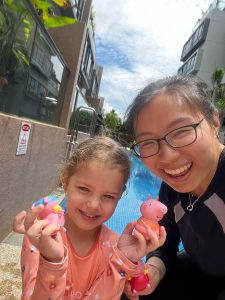Kids Swimming Lessons Singapore – Top 10 Coach Words (Parent Glossary)

kids swimming lessons Singapore is likely what you searched—now here’s what coaches actually say in class and why it helps your child learn faster. These 10 friendly cue words make complex skills simple, reduce fear, and build water confidence. Use this parent glossary to understand each cue and reinforce it at home for calmer, happier progress.
Table of Contents
- kids swimming lessons Singapore: Parent Glossary (Top 10)
- Why Short, Fun Cues Work for Young Swimmers
- How to Reinforce These Cues at Home
- Book a Warm-Water Trial (Indoor Heated Pool)
- FAQs
kids swimming lessons Singapore: Parent Glossary (Top 10)
1) Bubbles
What it means: Exhaling slowly through the nose and/or mouth underwater.
Why coaches love it: The first safety skill—bubbles prevent water rushing into the nose and build calm, rhythmic breathing. You’ll hear “Show me your bubble face!” or “Big bubbles!”
2) Kick, Kick, Kick!
What it means: The leg action for propulsion (fast, small flutter kicks; sometimes bigger “power” kicks).
Why coaches love it: A simple verb + rhythm hardwires timing. We cue “fast kicks,” “little kicks,” or “long kicks” depending on the goal and drill distance.
3) Streamline / Rocket Ship / Pencil
What it means: Arms straight above the head, ears hugged by the biceps, body long and straight.
Why coaches love it: The most hydrodynamic position. Fun visuals—“torpedo!” or “be a sharp pencil!”—help kids instantly align for push-offs and glides.
4) Scoop / Reach / Pull
What it means: Arm actions that “grab” and move the body through water.
Why coaches love it: Action words describe the feeling: “scoop the water,” “reach for the wall,” “pull past your hip.” It’s clearer than technical jargon for early learners.
5) Superhero Chest / Proud Chest
What it means: Keep the chest up and hips high so legs don’t sink.
Why coaches love it: Instead of “engage your core and maintain horizontal alignment,” we say “show your superhero chest!” Kids lift instantly and streamline improves.
6) Glide
What it means: A calm “coast” after a push or pull—holding streamline and letting the water carry you.
Why coaches love it: Teaches efficiency and balance. “Find your glide” reduces frantic movements and builds body awareness.
7) Popcorn / Motorboat (Bubbles)
What it means: Fun breathing games. “Popcorn” = bob up to breathe, down to blow bubbles. “Motorboat” = face in, blow a “brrrrr” bubble sound.
Why coaches love it: Turns a scary idea (face in water) into a playful challenge. Short, happy exposures build trust and control.
8) Big Arms / Windmill Arms
What it means: Freestyle (front crawl) arm action—wide, circular reaches that alternate.
Why coaches love it: A clear contrast to breaststroke pulls. “Big arms!” is simple, memorable and instantly shapes the motion.
9) Froggy Legs / Monkey-Airplane-Soldier
What it means: “Froggy legs” = breaststroke kick. “Monkey-Airplane-Soldier” = a backstroke teaching sequence (reach to the side, stretch wide, press to the body).
Why coaches love it: Imaginative cues break complex skills into memorable steps kids can copy without overthinking.
10) Starfish / Float on Your Back
What it means: Survival back float—arms and legs slightly out, eyes up, ears in.
Why coaches love it: A calming, positive image that teaches rest and safety. “Starfish” becomes a child’s reset when they need a breather.
Why Short, Fun Cues Work for Young Swimmers
- Lower cognitive load: One short word beats a complicated sentence, especially for toddlers.
- Consistency builds safety: Repeating the same cues helps children predict what’s next and stay calm.
- Play makes brave: Game-like names (rocket ship, popcorn) turn fear into curiosity.
- Body mapping: Visual words (“superhero chest”) help kids feel posture without technical talk.
This is why kids swimming lessons Singapore at Fabulous Swim focus on short, repeatable cues that build safety and confidence every week.
We embed these cues across our programmes—see baby swimming lessons, toddler stroke foundations, and our beginner drills for toddlers—especially at our indoor heated pool (primary venue). Condo coaching is available as a secondary option for families who prefer lessons at home pools.
How to Reinforce These Cues at Home
- Bath bubbles: Practise “bubbles” in the tub—slow exhales with a smile.
- Towel rocket: Arms up like a “rocket ship” while you wrap the towel—cue “streamline!”
- Bed starfish: “Starfish” lying on the bed with ears on the pillow to mimic back float posture.
- Wall walks: Hands along the bath rim (like pool “monkey walks”) to rehearse safe returns.
- Count & cue: Use “1-2-3 GLIDE!” for any short push-off game, even on land.
These simple games make kids swimming lessons Singapore feel familiar and fun every week.
Book a Warm-Water Trial (Indoor Heated Pool)
Choose what fits your family: small-group infant/toddler classes at our warm, indoor pool (102 Ulu Pandan—near Bukit Timah, Holland, Clementi) or condo coaching at your home pool (subject to rules). We’ll match you to the right coach and slot so progress stays happy and steady.
💙 Book a trial class • 📱 WhatsApp us • Explore kids & baby swimming lessons Singapore
Swim • Smile • Repeat.
FAQs
What age can my child start?
Many families begin from 4–6 months with parent-accompanied sessions. We focus on comfort, bubbles and supported floats—no forced dunking.
Do I need to repeat these words exactly at home?
Yes—consistency helps. Using the same cues (bubbles, rocket ship, starfish) builds confidence and speeds learning.
Are these cues used in both group and private lessons?
Absolutely. The core cues are consistent; we tailor the pace and drills to your child.
Will floaties help my child learn faster?
We prefer hands-on support in shallow water so kids learn real balance and breath cues. Floaties can change posture and create false confidence.
More reads: